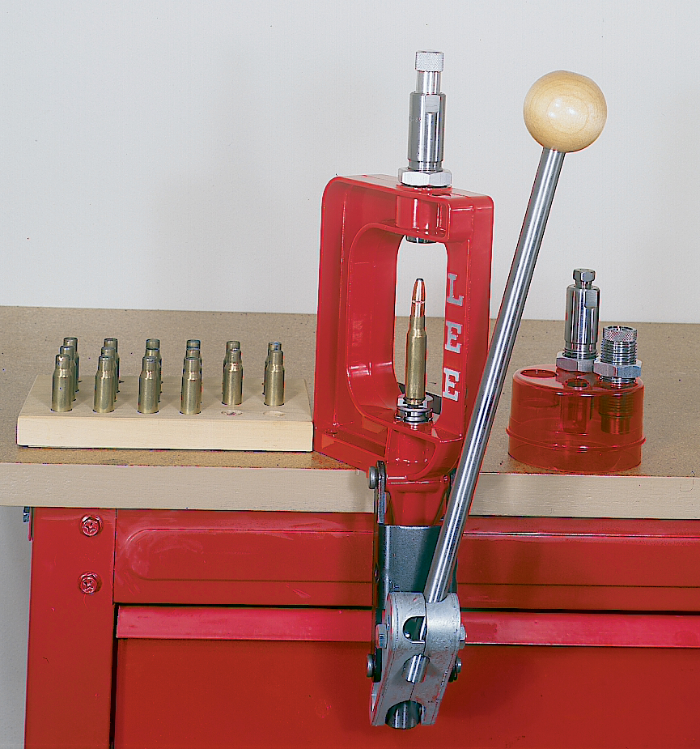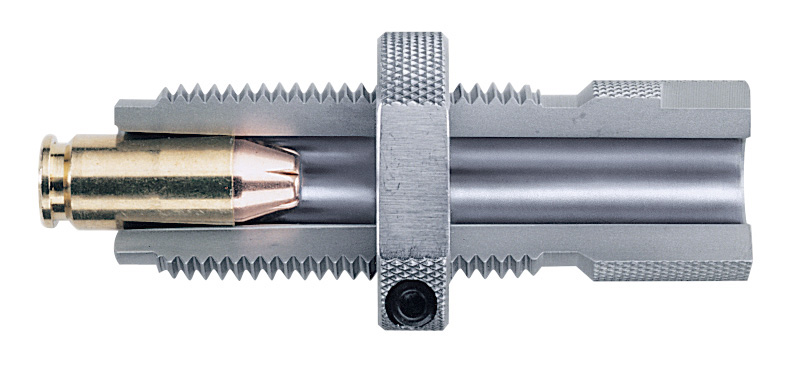More “factory tricks” can be applied to handloads, if you feel a need. READ MORE

Glen Zediker
A commonly used tactic in a factory round is a crimp to help hold the bullet in place before it’s launched, especially when there is a heavy bullet and heavy recoil. Inertia generated within the gun, in a big part, can make the bullet shift, usually outward (common in a magnum revolver). A crimp also helps guard against a bullet seating more deeply, as when there might some stubbing contact as the round is chambered.
For a true factory style roll crimp, the bullets must have a cannelure, or “crimping groove.” This is a ring cut into a portion of the bullet’s major diameter. The edge of the case mouth is turned or folded (“rolled”) into this groove to complete the crimp. The bullet seating die has to be tooled to provide this effect when it’s adjusted properly to engage the crimping groove. Not all seating dies can provide crimp.
If your die allows it, to get a crimp, adjust bullet seating depth to put the cannelure so it’s right on the end of the case mouth. Then adjust the die body downward to engage the crimping ledge so it will pinch the edge of the case mouth into the groove.

I don’t usually use a factory style roll crimp because I’ve never felt need for it, and also I convinced myself that it can’t be a good idea (ever) to squeeze in on a bullet, or not when best group size is the goal. Another reason is that I very rarely use a bullet that has a cannelure. However! I concede those times when it is a benefit. I crimp magnum handgun loads.
Also, if you crimp, it’s clear there are strict and unweilding limitations on bullet seating depth and also that all the cases have to be the same height for it to work properly, and that means at least a little additional tedium from efforts in case trimming.

An alternative to a roll crimp is a “taper crimp.” This is popular with practical-style pistol competitors and also with a couple of commercial .223 Rem. loaders I know. A taper crimp die does what it suggests or sounds like it does: it squeezes in some portion below the case mouth against the bullet using a gentle taper. Anyone who’s loaded straight-walled cases knows about “belling” the case mouth. Belling makes a little funnel-edge on the case mouth to allow easy entry for a bullet. That tiny trumpet-shaped area then needs to be ironed back flat so the round will chamber, and the seating die has a portion within it dimensioned and devoted to this chore. A taper crimp die works in the same, just more.

And, as said, a taper crimp is a stand-alone die, which means it’s best used in a turret or progressive style press. Its use effectively increases the grip against the bullet. Some say it’s an asset to reliable feeding, and I can agree with that given straight-wall cases, but I don’t think it helps a bottleneck case in this regard. It will, however, keep the bullet better in place against outside forces seeking to change its location.

Last, for now, is that there are also a good many who claim that crimping is an asset to improving round to round velocity consistency. Judge that, along of course with your chronograph, but I have yet to see it in rifle ammunition. Some pistol ammo, yes.
Check out Midsouth taper crimp dies HERE
Lee “Factory Crimp” HERE
The preceding is a adapted from information contained in from Glen’s newest book America’s Gun: The Practical AR15. Available at Midsouth Shooters Supply. Visit ZedikerPublishing.com for more information on the book itself, and also free article downloads.








